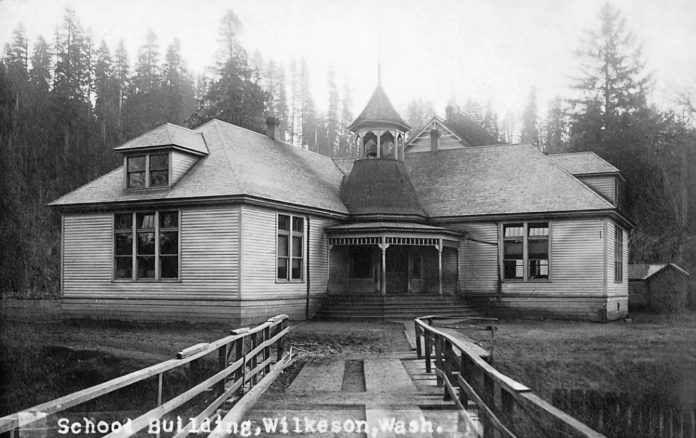For more than a century the start of a school year has coincided with Labor Day, often considered the end of summer. This practice dates back to a time when family farms in agrarian areas needed children to help plant and care for crops. Thus, the school year typically started in early September and ended in mid-spring. With more holidays, longer Christmas breaks, snow days, mid-winter breaks, and staff days, many schools now start before Labor Day and extend until late June.
In the Pierce County coal mining town of Wilkeson during the early 1900s, this school was located ‘uptown’ adjacent to the new school built in 1913 that eventually replaced it and still stands. The first school, situated at the site of the current fire station, 501 Church Street, burned down in Dec. 1887, after which students attended school in a church until this new structure was built about 1899. This was Wilkeson’s second school and was eventually comprised of two buildings, with the second building’s roof line visible to the right of the cupola.
In the late 1890s and early 1900s, most of the town’s school age children attended school in this building, at least until 8th grade. However, it wasn’t unusual for boys as young as 10 or 12 to start working in the coal mines as “trappers” opening and closing the mine portal doors that preserved sufficient air flow throughout the mine. And a number of girls quit school after 3rd or 4th grade to assist their mothers in cooking, cleaning, washing, sewing, plus caring for chickens or cows, if the family was fortunate enough to own some. Students who attended high school traveled daily to and from Buckley five miles away, about a 90 minute walk each way, though some rode horses.
Though architecturally appealing, this school building lacked modern conveniences. According to Nancy Irene Hall’s description in “Carbon River Coal Country” students and staff used old-fashioned, outdoor toilets called out-houses. The out-houses were behind the school balanced over Wilkeson Creek. There was a set for boys, a set for girls, and another for teachers. The smell wasn’t particularly pleasant until the creek flooded during high water, after which the out-houses smelled “fresh as a daisy.”
The boys of the school enjoyed an ancient sport – trying to sneak a peek at the girls’ underwear, then called bloomers. At that time most bloomers were made at home by mothers, typically out of an empty flour sack with the brand name often intact. The boy’s sport was spotting the brand name to tease the girl about their underpants.
This photo comes courtesy of the George & Mary Ann Morris family archives and Palmer Coking Coal Co. Additional information about Wilkeson’s schools was provided by Sara Sutterfield. Photo enhancements were undertaken by Doug ‘Boomer’ Burnham, a Tahoma High School teacher whose business name is: www.BoomersPhotography.com. Next week’s column features the new three-story school constructed in 1913 using Wilkeson stone. It still serves students today.







